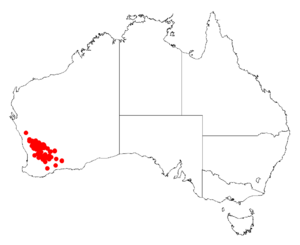Acacia mackeyana facts for kids
Quick facts for kids Acacia mackeyana |
|
|---|---|
| Scientific classification | |
| Genus: |
Acacia
|
| Species: |
mackeyana
|
 |
|
Acacia mackeyana is a special type of shrub that grows in the dry southwestern part of Australia. It belongs to the big Acacia plant family. This plant is endemic to Australia, which means it naturally grows only in this specific area and nowhere else in the world.
What it Looks Like
This Acacia is a thick, bushy shrub that can grow from 0.5 to 1.7 metres (2 to 6 ft) tall. It often has a rounded or cone-like shape. Its small branches are a bit hairy. It also has tiny, thick, black, triangular parts called stipules, which are less than 1 mm (0.039 in) long.
Like most Acacia plants, it doesn't have regular leaves. Instead, it has phyllodes. These are like flattened leaf stems that do the job of leaves. The phyllodes on Acacia mackeyana stand upright and are stiff and smooth. They can be straight or slightly curved.
These phyllodes are about 0.7 to 3 cm (0.28 to 1.18 in) long and 1 to 2 mm (0.039 to 0.079 in) wide. They have a sharp, pointed tip and feel prickly. You can see about 20 thin lines, called nerves, running very close together along each phyllode. This plant blooms from June to August, showing off its bright yellow flowers.
Where it Grows
Acacia mackeyana is found in several regions of Western Australia. These include the Mid West, Wheatbelt, Great Southern, and Goldfields-Esperance areas.
You can often find this shrub growing on rocky hills, sudden drops in the land called breakaways, and flat, wavy sandy areas. It prefers sandy, loamy, or clay-loam soils. These soils are often found over or around laterite (a type of red soil) or granite rocks.
Most of these plants grow in an area stretching from Coorow in the northwest down to Corrigin, Western Australia and Moorine Rock in the southeast. You can also find smaller groups of them near Mullewa, Ongerup, Ravensthorpe, and in the Frank Hann National Park.

